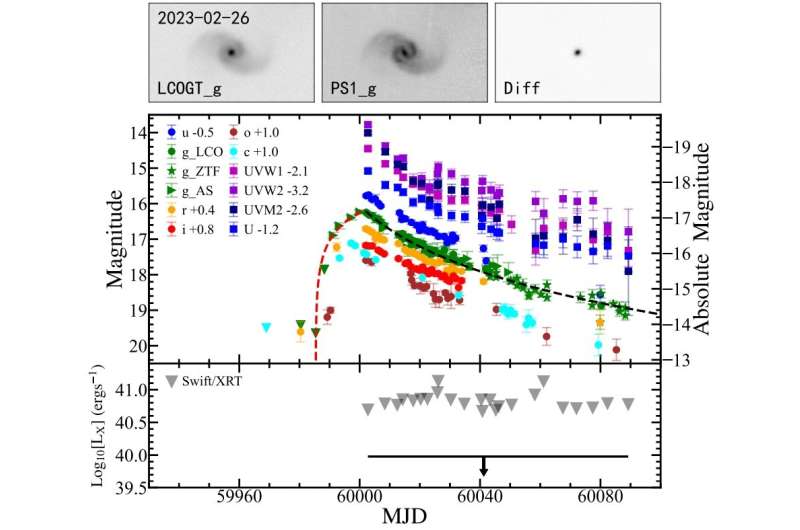Top left: LCOGT g-band image which was taken on 2023-02-26 UT. Top middle: PanSTARRS g-band stack image of the host galaxy. Top right: Difference image of AT 2023clx. Middle: Host-galaxy-subtracted light curves of AT 2023clx in the UV and optical bands. Credit: Zhu et al, 2023
Astronomers from the University of Science and Technology of China in Hefei report the discovery of a new faint tidal disruption event (TDE). The newfound TDE, designated AT 2023clx is the faintest and closest optical TDE so far detected. The finding was published July 10 on the preprint server arXiv.
TDEs are astronomical phenomena that occur when a star passes close enough to a supermassive black hole and is pulled apart by the black hole's tidal forces, causing the process of disruption. Such tidally disrupted stellar debris starts raining down on the black hole, and radiation emerges from the innermost region of accreting debris, which is an indicator of the presence of a TDE.
For astronomers and astrophysicists, TDEs are potentially important probes of strong gravity and accretion physics, providing answers about the formation and evolution of supermassive black holes.
Now, a team of astronomers led by Jiazheng Zhu has found a new TDE in a nearby star-forming galaxy known as NGC 3799. Using mainly the Las Cumbres Observatory Global Telescope network (LCOGT) and NASA's Neil Gehrels Swift Observatory, they conducted follow-up observations of AT 2023clx—a transient source initially identified in 2014. The observational campaign confirmed the previous assumption that AT 2023clx is a faint TDE.
"In this work, we report the discovery of a new faint TDE in NGC 3799, a main-sequence star-forming galaxy located at a distance of only ∼50 Mpc," the researchers wrote in the paper.
According to the study, the optical/UV and bolometric light curves showcase a power-law decay after the peak AT 2023clx, which is not as fast as that of other faint TDEs. However, the spectra taken around the optical peak exhibit a strong blue continuum, with a blackbody temperature of about 12,000 K and broad Balmer lines blended with helium features, reminiscent of other known faint TDEs.
Furthermore, the maximum blackbody luminosity of AT 2023clx was found to be only 4.56 tredecillion erg/s. The astronomers noted that this finding makes AT 2023clx even fainter than previously identified low-luminosity TDEs.
The authors of the paper added that with a luminosity distance of approximately 155.8 million light years, AT 2023clx is also the closest known optical TDE. The host galaxy NGC 3799 is estimated to be some 160 million light years away from the Earth.
Summing up the results, the researchers noted that the detection of the tidal disruption event AT 2023clx raises hopes for more discoveries of such faint TDEs in the future.
"This finding further demonstrates that the luminosity function (LF) is continuously rising towards the low end, and there are likely many more faint TDEs waiting to be discovered," the scientists concluded.
More information: Jiazheng Zhu et al, AT 2023clx: the Faintest and Closest Optical Tidal Disruption Event Discovered in Nearby Star-forming Galaxy NGC 3799, arXiv (2023). DOI: 10.48550/arxiv.2307.04297
Journal information: arXiv
© 2023 Science X Network
























